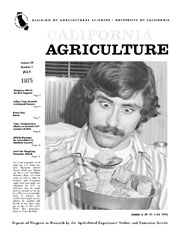All Issues

Cover:
It’s a real eyepopper of an idea, but U.C. Davis student Raymond Sunseri doesn’t think any human can eat a cow’s breakfast. However, these rice straw cubes, as well as other alternative and by-product cattle feeds now under development by U.C. researchers, may be staple feed for animals of the future. This project and other work to enhance the world‘s food supply was explained by students and faculty at the Davis campus as part of this year’s Picnic Day actiuities - Photo by Tracy Borland
July 1975
Volume 29, Number 7
Volume 29, Number 7





